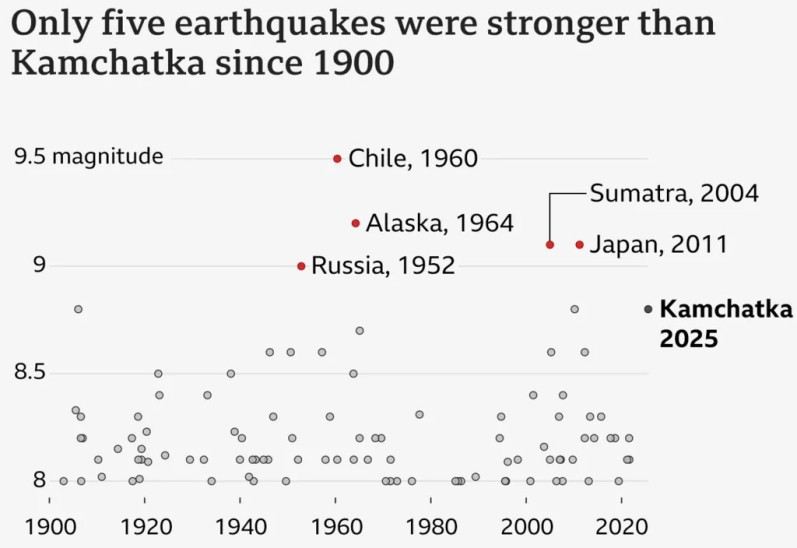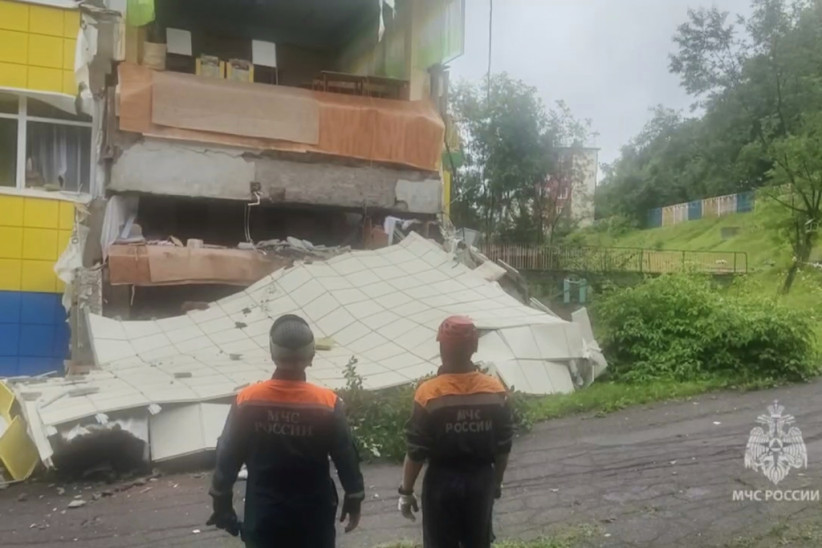One of the strongest earthquakes ever recorded was noted in the Eastern Russiabut without – at least for the time being – to cause the devastating tsunami that many were afraid of.
The 8.8 magnitude earthquake on the Richter scale occurred on Wednesday at 11:25 local time (00:25 Greek time), causing concern about coastal areas throughout the Pacific.
Millions of people have been removed from their homes, as memories of the December 26, 2004 tsunami in the Indian Ocean and Japan in 2011 returned to the forefront – both of which were caused by earthquakes of similar size.
However, today’s tsunami was much milder, although it caused damage to some areas. So what caused the earthquake and why didn’t it evolve into absolute disaster?
See here in detail all the developments from the 8.8 Richter earthquake off the coast of Russia
What causes a mega earthquake
OR Kamchatka Peninsula It is an isolated area, but it is located within the so -called “Ring of Pacific Fire”, where most seismic and volcanic activities in the world occur.
The upper layers of the Earth consist of tectonic plates, which are constantly moved. The “Ring of Fire” is formed by the contact of these plates around the Pacific. According to the British Geological Service, 80% of earthquakes on the planet happen there.
Open Kamchatka, the peaceful plate moves northwest at a rate of about 8 cm per year – just twice the speed at which our nails grow, but extremely quickly with geological criteria.
There, it meets the small Ohotsk – the peaceful plate is ocean, that is, it consists of heavier rocks, and therefore dives under the lightest microplace.
As the peaceful plate sinks to the interior of the earth, he is heated and melted, gradually disappearing. But this process is not always smooth: the plates can “stick” with each other, accumulating huge pressure that is abruptly relieved.
This is exactly what happened now: this is a “megathrust” earthquake – a megasy in which the plates are subjected to sudden slip.
“When we think of an earthquake, we imagine a point on the map. But in very large earthquakes, the rupture extends to hundreds of kilometers“, Explains Dr. Steven Hicksseismology lecturer in University College London. “The huge shift and extent of the rupture is the one that leads to such a high size“
It is noted that the strongest earthquakes in history – in Chile; Alaska and Sumatra – It was also megathrusts.
Kamchatka has a history of large earthquakes: in 1952 there was an earthquake of 9 Richter less than 30 km from today.
Why the tsunami was not as disastrous as in previous cases
The sudden movement of the plates can move huge masses of water, which are directed to the shore as a tsunami.
In the open ocean, the waves are moving at a speed of over 800 km/h – as much as a passenger plane – with long intervals and low height (rarely over 1 meter).
But as they approach land and the water is shallow, slowing down, the space between them is shrinking and the height increases – sometimes creating “water walls”. Nevertheless, a strong earthquake does not necessarily imply a tsunami of high height or penetration of land.
According to Russian authorities, waves of up to 4 meters in some parts of eastern Russia were recorded today.
This is not compared to the tens of meters high waves in the Indian Ocean in 2004 and Japan in 2011.
“The height of the wave is affected both by the relief of the seabed but also by the morphology of the coast“, Explains tectonics professor Lisa McNill by the University of Southampton. “Also how densely populated the coast is affecting the size of the damage“
OR American geological service He said the earthquake had a focal depth of about 20.7 km – shallow enough to cause significant shift of the seabed.
“Perhaps the tsunami models were based on conservative evaluation of the depth“, Commented Dr. Hicks to Bbc. “Assuming the focus was 20 km deeper, the height of the waves would be significantly smaller“
The importance of early warning systems
Advanced warning systems also play a decisive role today.
Due to the frequency of earthquakes in the Pacific, many countries have special tsunami warning centers, issuing public announcements and evacuation orders.
In 2004, there was no such system in the Indian Ocean – resulting in over 230,000 victims in 14 countries.
The warning systems are critical, since scientists cannot accurately predict when an earthquake will occur.
The US Geological Services had recorded an earthquake of 7.4 Richter in the same area just 10 days ago. This may have been an intent – that is, an early energy relief – but it cannot predict exactly when the main event will follow.
“Although we monitor the speeds of tectonic plates, we measure GPS displacements and study the earthquake history, we can only predict the probability, not the exact time“, Explains Professor McNill.
The Geophysical Institute of the Russian Academy of Sciences (GS RAS) It continues to monitor the area, expecting aftershocks for at least another month.
Source :Skai
With a wealth of experience honed over 4+ years in journalism, I bring a seasoned voice to the world of news. Currently, I work as a freelance writer and editor, always seeking new opportunities to tell compelling stories in the field of world news.












